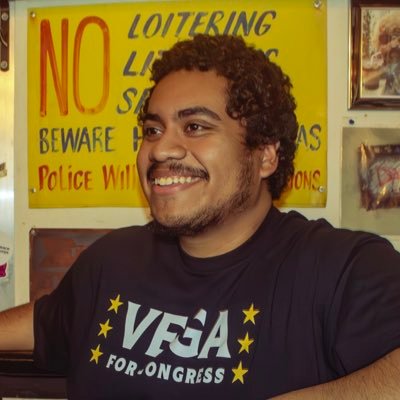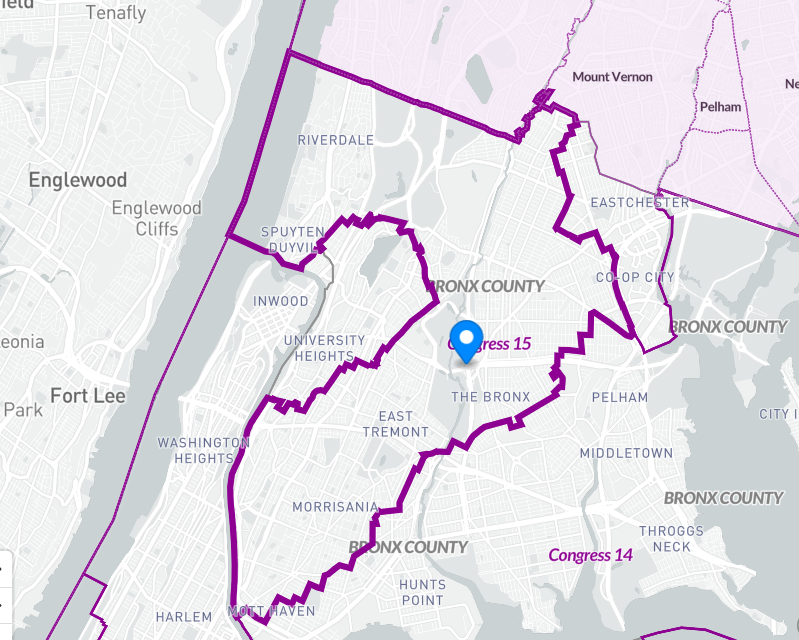
Photo courtesy of Jose Vega
Jose Vega, a member of the international LaRouche Youth Movemement since 2014, is running for Congress in New York’s 15th Congressional District on Election Day, Nov. 5, on the LaRouche Party ticket. The LaRouche Party.
“I am running to break down the barriers that silence the people’s voices. We must empower citizens to reclaim their stake in government, restore trust, and dismantle corruption. Together, we can restore faith in a government that truly serves its people.”
According to Wikipedia, the LaRouche movement is a political and cultural network promoting the late Lyndon LaRouche and his ideas. It has included many organizations and companies around the world, which campaign, gather information and publish books and periodicals. LaRouche-aligned organizations include the National Caucus of Labor Committees, the Schiller Institute, the Worldwide LaRouche Youth Movement and, formerly, the U.S. Labor Party. The LaRouche movement has been called “cult-like” by The New York Times.
According to the U.S. Department of Justice, LaRouche began his political odyssey from the far left to the far right in the 1940s as part of the Socialist Labor Party and since that time has organized a small but fanatical core group of followers whose influence is felt at every level of America’s political process. “LaRouche has had frequent encounters with the law and has voiced his blatant anti-Semitism. He has also made outrageous accusations against prominent political figures, such as accusing the Queen of England of being the head of an international Jewish drug conspiracy and calling Henry Kissinger a Soviet spy,” an extract from the Justice department reads.
In terms of his policy platform, Vega said his policies are a key part of his strategy to offer the people of The Bronx a vision of the future they can create for themselves. “You don’t need to agree with these ideas, you need to make these policies a subject of heated debate within your communities to fight the censorship and media lies,” he writes on his website.
Vega said the young people of the South Bronx today are faced with a miserable and hopeless future, which he said is “the result of 50 years of benign neglect, planned shrinkage, and indifference of those who have shaped New York City’s financial and related policies.” He said a report from New York State Comptroller Thomas DiNapoli, revealed in December 2022 that the Bronx had the highest poverty rate in the state at around 24%.
He said the South Bronx itself has over 40% of its children living in poverty and adds that the report also found that among 16-to-24-year-olds in New York City, 18% of them are unemployed, with unemployment among young men hovering at 24%. Vega believes these figures are underestimated in terms of the true unemployment rates, and when coupled “with ‘underemployment’ rates in the form of unproductive service and retail jobs.”
Vega said a similar situation confronted the country in the onset of the Great Depression in 1929. He said by the time former U.S. President Franklin D. Roosevelt was inaugurated in 1933, at least a third of the working population was unemployed. He said Roosevelt, within only 100 days of his administration, realized the need to revive and transform the country’s gutted physical economy through rigorous, extensive programs such as the Glass-Steagall Act, the Works Progress Administration (WPA), the Reconstruction Finance Corporation, and more. One of these programs was the Civilian Conservation Corps (CCC).
Vega said that operating in camps, supervised by military personnel and professional workers, over 3 million young people between the ages of 18-25 were recruited to learn the basics of productive labor, and what it meant to work in a disciplined, cooperative work environment. He said many had been illiterate, impoverished, demoralized, and troubled youth, and by the end of their training, they would come out intelligent, skilled, and productive workers, with many of their future employers praising their work ethic.
He said by the end of the CCC’s tenure in 1941, over 4 million acres of trees were thinned, a billion fish stocked, and more than 30,000 wildlife shelters were built. He said along with this, over 7,000 canals and diversion ditches were dug, along with thousands of roads, bridges, buildings, and other infrastructure being built. He said the CCC became known for its work on reforestation, helping to plant more than 3.5 billion trees across the country, in difficult circumstances.
Vega said after their training, many of the CCC workers went on to fight the war against fascism, while some stayed at home to build the “arsenal of democracy.” By the end of the war, he said the United States would emerge as the most powerful economy in the world. He said unfortunately, the CCC was never revived after World War II, but Vega believes it still remains a viable model for the South Bronx and other parts of the city.
He writes, “A program for today, however, wouldn’t involve simply teaching people ‘practical’ skills, but would instead be a mobilization to completely revamp New York City and other parts of the United States, through construction of massive infrastructure, and discovery in technologies of the future. This would be done, through a new and revitalized “Space CCC” for the 21st Century.”
Vega said there is a need for hundreds of small and large-scale nuclear power plants across the country, a 42,000-mile high-speed rail network connecting major cities and other areas, and the construction of new hospitals, schools, sewer systems, and levees on collapsing U.S. waterways system. He said abandoned military bases, vacant manufacturing facilities, shopping centers and unused land could be converted into campuses, where food and care would be provided.
He said Space CCC enrollees would not only work in urban settings, but many in the nation’s forests, fields, and state parks, which he said provide an invaluable educational experience and sense of the world. He said this would especially be crucial for the large numbers of inner city youth plagued by an environment of drug addiction.
He said students of the Space CCC program would become highly-skilled engineers, scientists and tradesmen, which would necessitate an intensive educational component to the program. He said he would ensure enrollees were given intensive on-the-job training, a clear educational curriculum to ensure a grounding in basic elementary subjects, along with the ability to read and write.
Vega said the Space CCC would be trained in vocational skills, producing skilled machinists, carpenters, plumbers, and electricians, and an enrollee of 16 would spend 2 to 3 years mastering their trade. “By the time they’re 22, they will become a skilled engineer contributing to the modernization of their communities and neighborhoods,” he wrote.

Source: CUNY Graduate Center
Vega said a cultural program, based on classical principles of art, music and poetry, would also be added to the curriculum in order to inspire and increase the creative capabilities of each student’s mind and heart, adding that in a certain setting, there is “no difference between science and art.”
He said the Space CCC would also be given the mission of exploring new exciting frontiers in space, and contributing to the leading thrust of a new, revitalized space program. He laments the decreased funding in NASA versus what it had been in the 1960s.
On the economy, Vega said he was committed to making the South Bronx a model for a new, advanced productive labor-force, composed of the now-neglected youth of the city. “The United States is now on the precipice of an unprecedented financial meltdown, as is reflected in the now $34 trillion national debt and the soaring interest payments arising from such debt,” he said. “As was revealed in the 2008 financial crisis, the economy is essentially dead, surviving on the reckless creation of liquidity into an over indebted system at the cost of neglecting the physical capabilities of the economy.” He said a revived U.S. workforce, not based on the so-called “service economy,” but on real productivity, would put the United States on the right track.
His economic policy is to begin an immediate, emergency-basis study of the history of the national system of political economy as it has existed in the U.S., beyond popular mythologies such as “the invisible hand of the market.” Equipped with such knowledge, he said one could then begin to understand the current global epochal shift occurring in favor of the principle of national sovereignty with the rise of the BRICS-Plus nations, and only then could one know what national policy determinations are appropriate for the U.S. today.
In terms of other policy issues, Vega references when on Sunday, Feb. 25, U.S. Air Force member Aaron Bushnell set fire to himself in front of the Israeli embassy in Washington D.C. “showcasing to the world the fate of over 30,000 Palestinians in the Gaza Strip.” He said over 90% of children under five now face disease, starvation, and rampant poverty, as a result of Israel’s bombing campaign in Gaza in response to the Oct. 7, 2023 attacks on Israel.
He said, “Bushnell’s act shows that we cannot ignore what is going on now in the Gaza Strip, in much the same way those who participated in the acts of the Nazi Regime, out of ignorance, fear, or malice, ‘knew, or should have known’ the consequences of their actions.” Vega cites the over 1 million young people in the Gaza region, who he said were not even born in the last election cycle that occurred in 2005. He said in order to give those young people hope, a real solution of peace and economic development must be realized for the Gaza Strip, and the greater region as a whole.
As an independent candidate for U.S. Congress in NY-15, Vega said he endorses American statesman and economist Lyndon LaRouche’s Oasis Plan as a first step towards peace for the region. First proposed in 1975, he said the Oasis Plan addressed the greatest barrier for development in the Middle East: the shortage of freshwater due to the arid nature of the region. [Israel has traditionally controled the water supply into the West Bank.]
Vega said through the intervention of science and human ingenuity, the region could be transformed from a dry desert into a blossoming oasis, utilizing a network of nuclear-powered desalination plants that could turn the plentiful sea water in the Mediterranean, into freshwater that would be used for irrigation and agriculture, along with greening the vast deserts of the region. He said accompanying the water and power development would be a network of transportation, water-management, and other projects to provide the foundation for advanced, industrialized cities.
He said an immediate ceasefire would be the obvious first step to ending the conflict in the region, but a permanent solution could only come by considering the region 50 years from now. “A lasting peace must be brought to this great historic region, a place which has brought us the wonderful religious and cultural achievements of Judaism, Islam, and Christianity,” Vega said. “By uniting these different cultures, through a principle of Reason which takes into account the common needs of the people in the region, a true and lasting peace will be brought about.”
Congressional District 15 stretches from the northwest of the borough to the South Bronx, and is represented by Democratic Congressman Ritchie Torres.
Polls are open on Election Day from 6 a.m. to 9 p.m. Find your poll site at FindMyPollsite.Vote.NYC.




